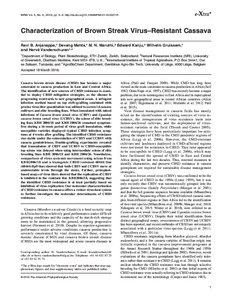| dc.contributor.author | Anjanappa, R.B. |
| dc.contributor.author | Mehta, D. |
| dc.contributor.author | Maruthi, M.N. |
| dc.contributor.author | Kanju, E. |
| dc.contributor.author | Gruissem, W. |
| dc.contributor.author | Vanderschuren, H. |
| dc.date.accessioned | 2019-12-04T11:03:51Z |
| dc.date.available | 2019-12-04T11:03:51Z |
| dc.date.issued | 2016-07 |
| dc.identifier.citation | Anjanappa, R.B., Mehta, D., Maruthi, M.N., Kanju, E., Gruissem, W. & Vanderschuren, H. (2016). Characterization of brown streak virus–resistant cassava. Molecular Plant-Microbe Interactions, 29(7), 527-534 |
| dc.identifier.issn | 0894-0282 |
| dc.identifier.uri | https://hdl.handle.net/20.500.12478/1260 |
| dc.description.abstract | Cassava brown streak disease (CBSD) has become a major constraint to cassava production in East and Central Africa. The identification of new sources of CBSD resistance is essential to deploy CBSD mitigation strategies, as the disease is progressing westwards to new geographical areas. A stringent infection method based on top cleft–grafting combined with precise virus titer quantitation was utilized to screen 14 cassava cultivars and elite breeding lines. When inoculated with mixed infections of Cassava brown streak virus (CBSV) and Ugandan cassava brown streak virus (UCBSV), the scions of elite breeding lines KBH 2006/18 and KBH 2006/26 remained symptom-free during a 16-week period of virus graft inoculation, while susceptible varieties displayed typical CBSD infection symptoms at 4 weeks after grafting. The identified CBSD resistance was stable under the coinoculation of CBSV and UCBSV with cassava geminiviruses. Double-grafting experiments revealed that transmission of CBSV and UCBSV to CBSD-susceptible top scions was delayed when using intermediate scions of elite breeding lines KBH 2006/18 and KBH 2006/26. Nonetheless, comparison of virus systemic movement using scions from KBH2006/18 and a transgenic CBSD resistant 60444 line (60444-Hp9 line) showed that both CBSV and UCBSV move at undetectable levels through the stems. Further, protoplast-based assays of virus titers showed that the replication of CBSV is inhibited in the resistant line KBH2006/18, suggesting that the identified CBSD resistance is at least partially based on inhibition of virus replication. Our molecular characterization of CBSD resistance in cassava offers a robust virus-host system to further investigate the molecular determinants of CBSD resistance. |
| dc.description.sponsorship | European Union |
| dc.format.extent | 527-534 |
| dc.language.iso | en |
| dc.subject | Cassava |
| dc.subject | Plant Diseases |
| dc.title | Characterization of brown streak virus–resistant cassava |
| dc.type | Journal Article |
| dc.description.version | Peer Review |
| cg.contributor.crp | Roots, Tubers and Bananas |
| cg.contributor.affiliation | Eidgenössische Technische Hochschule Zürich |
| cg.contributor.affiliation | University of Greenwich |
| cg.contributor.affiliation | International Institute of Tropical Agriculture |
| cg.contributor.affiliation | Université de Liège |
| cg.coverage.region | Africa |
| cg.coverage.region | Central Africa |
| cg.coverage.region | East Africa |
| cg.coverage.country | Uganda |
| cg.isijournal | ISI Journal |
| cg.authorship.types | CGIAR and advanced research institute |
| cg.iitasubject | Cassava |
| cg.iitasubject | Food Security |
| cg.iitasubject | Plant Diseases |
| cg.journal | Molecular Plant-Microbe Interactions |
| cg.howpublished | Grey Literature |
| cg.accessibilitystatus | Limited Access |
| local.dspaceid | 78582 |
| cg.targetaudience | Scientists |
| cg.identifier.doi | https://dx.doi.org/10.1094/mpmi-01-16-0027-r |

